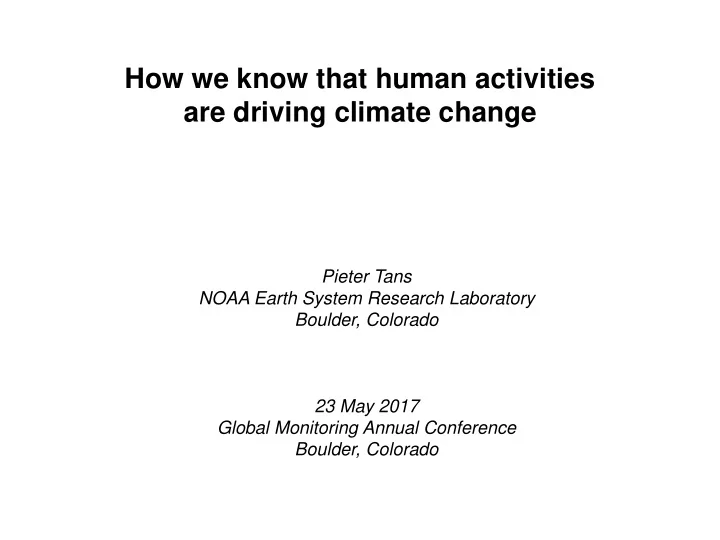

How we know that human activities are driving climate change Pieter Tans NOAA Earth System Research Laboratory Boulder, Colorado 23 May 2017 Global Monitoring Annual Conference Boulder, Colorado
EMISSIONS ARE OVERWHELMING NATURAL PROCESSES www. esrl.noaa.gov/gmd/ccgg/trends/
TODAY’S CO2 IS HIGHLY ANOMALOUS 800,000 year history of atmospheric carbon dioxide ice core 400 Mauna Loa central Antarctic Antarctica coast 300 200
TODAY’S CO2 IS HIGHLY ANOMALOUS 6300 years 70 years 100 ppm span 100 ppm span
ISOTOPIC EVIDENCE FOR THE SOURCES OF TODAY’S INCREASE 14 C/C sample 13 C/ 12 C sample – 13 C/ 12 C reference δ 13 C ≡ 13 C/ 12 C reference 14 C/C reference δ 13 C 13 C/ 12 C ratio (approximate) (approximate) Carbonate rock 0 ‰ 0.011237 0 Atmosphere −8 ‰ 0.011147 1.04 From oceans −8 ‰ 0.011147 1.06 Terrestrial biosphere −26 ‰ 0.010945 1.07 Coal −24 ‰ 0.010967 0 Oil −28 ‰ 0.010923 0 Natural gas −45 ‰ 0.010732 0
ISOTOPIC EVIDENCE FOR THE SOURCES OF TODAY’S INCREASE Observations: the added CO2 is depleted in 13 C Sources: CSIRO, ESRL, INSTAAR
ISOTOPIC EVIDENCE FOR THE SOURCES OF TODAY’S INCREASE The CO2 added to the atmosphere is of organic origin This would have been observed if the extra CO2 had come from volcanoes or from the oceans…. Observations: the added CO2 is depleted in 13 C Sources: CSIRO, ESRL, INSTAAR
ISOTOPIC EVIDENCE FOR THE SOURCES OF TODAY’S INCREASE The organic material is very old
WHAT HAPPENED TO CO2 EMITTED FROM FOSSIL FUEL BURNING? Gton C Cumulative fossil fuel emissions (Jan. 2010) 355 ± 25 (source: CDIAC) Observed atmospheric increase (Jan. 2010) 231 ± 10 (source: ESRL) Observed ocean increase through 1994 118 ± 19 (Sabine et al., Science 2004) 145 modeled oceans, extrapolated through 2009 mass balance: fossil fuel emissions = atmos increase + ocean increase + terrestrial biosphere P.Tans, Oceanography 22 (4), 26-35, 2009
ATMOSPHERIC NORTH-SOUTH GRADIENT PROPORTIONAL TO GLOBAL EMISSIONS
THE GREENHOUSE EFFECT IS WELL UNDERSTOOD, AND OBSERVED Outgoing infrared radiation (clear skies) from Earth to space as a function of wavelength over the Sahara desert. Measured by Nimbus 4 satellite in 1970 IR “window” regions H2O O3 INTENSITY CO2 CH4 H2O Hanel, JGR 1972
ENHANCEMENT OF THE GREENHOUSE EFFECT Climate forcing by long lived GHGs (Watt m -2 ) CO2 CH4 N2O F-12 F-11 minor TOTAL %solar 1950 0.572 0.244 0.059 0.875 0.348 1980 1.058 0.413 0.104 0.097 0.042 0.034 1.747 0.728 2000 1.512 0.481 0.151 0.173 0.066 0.083 2.467 1.028 2013 1.882 0.496 0.184 0.167 0.059 0.114 2.901 1.209 2014 1.908 0.499 0.187 0.166 0.058 0.116 2.935 1.223 2015 1.939 0.504 0.190 0.165 0.058 0.118 2.974 1.293 Annual Greenhouse Gas Index: www.esrl.noaa.gov/gmd/aggi/
WHAT DO WE OBSERVE? INDEED, THE EARTH IS WARMING, AS EXPECTED
INTO THE FAR FUTURE, THOUSANDS OF YEARS observed
INTO THE FAR FUTURE, THOUSANDS OF YEARS Total retained energy by enhanced CO 2 alone, 1750-2500 , would be enough to raise the temperature of the upper 1000 m of the oceans by 12 degree C Total retained energy by all GHGs, 1750-2100, raises T by 5 degree C Not considered: negative climate forcings (cooling) such as fine particles (haze, also called aerosols) and their effects on clouds. Increased aerosols are also due to human activities. Earth’s observed heat budget 1950-2004 (D. Murphy, JGR 2009): (Excess retained heat by GHGs ~half of one solar radiation-year) 12% for heating of oceans 21% for increased IR radiation to space (cooling from warmed surface) 18% compensating cooling from stratospheric aerosols (volcanoes) ~50% compensating residual cooling, mostly by human-caused aerosols
Based on observations and well understood physics and chemistry, human actions have committed the Earth to significant climate change for thousands of years. Additional commitment is growing at a record pace. Modeled predictions of climate change span a large range but do not negate the above conclusions in any way.
Recommend
More recommend